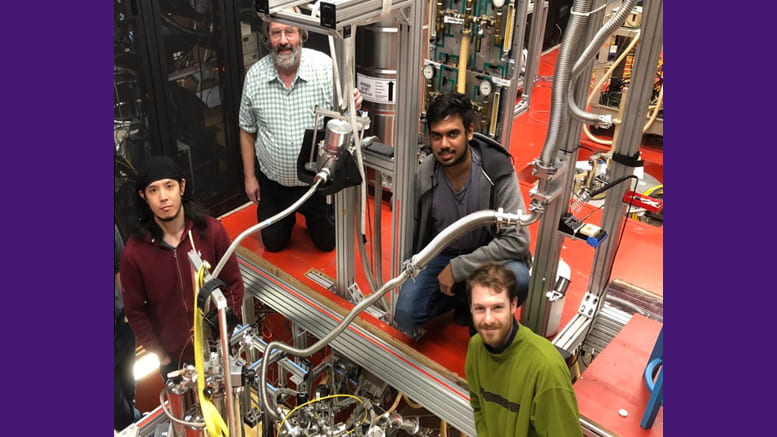A triumph for fundamental physics: With a more precise measurement of the electron’s magnetic moment, researchers unlock opportunity for physics discovery
April 18, 2023

For something so precise, so miniscule, this was big. Really big.
A new measurement of the electron magnetic moment from Board of Trustees Professor in Physics Gerald Gabrielse and his research group at Northwestern University’s Center for Fundamental Physics has delivered the most precise measurement of a property of any elementary particle. At the part per trillion level, the measurement improves the previous result – a 15-year-old discovery also made by a Gabrielse-led team – by a factor of two.
Physics, the publication tracking groundbreaking results in the field, called the Northwestern group’s work “a triumph for fundamental physics.”
“It’s a great triumph,” Gabrielse said, “but also a great frustration.”
At present, the Standard Model of Particle Physics is the world’s best description of physical reality. Gabrielse acknowledges the Standard Model is a battle-tested theory capable of predicting nearly everything humans can measure and test on Earth. When it comes to the universe, however, the Standard Model falls short and fails to account for basic features.
“The quest we’re on is to make the most precise measurements of properties of elementary particles to probe the Standard Model’s most precise prediction,” Gabrielse said.
The path to precision
When Gabrielse arrived at Northwestern in 2017, wooed to Evanston following nearly three decades at Harvard University, the renowned scientist with a self-deprecating style joked that he hoped Northwestern leaders wouldn’t come to view his presence as a “huge mistake.”
After all, Gabrielse understood more exact measurements of the electron magnetic moment required years to complete and demanded new methods, new apparatus and unflinching detail. And yet, Gabrielse and his group weren’t deterred.
Xing Fan, a one-time graduate student of Gabrielse’s at Harvard and now a research assistant professor at Northwestern, worked closely with Gabrielse on constructing a new cryogenic device capable of boosting the precision of measurements.
“Fan’s fingers and brain are all over this work,” Gabrielse said, adding that Northwestern graduate students Benedict Sukra and Thomas Myers also made significant contributions.
Over recent years, Gabrielse and his group used “a lot of quantum tricks” to improve the magnetic and refrigeration capabilities of their apparatus as well as its mechanical stability. Those efforts “reduced noise,” Fan said, allowing for more stable and consistent preparation of experiments.
“We reduced the number of assumptions or models to achieve an extremely clean environment to improve the precision of the measurement,” Fan said.
In time, the researchers arrived at a measurement of the magnetic moment so precise that Wired – by way of Fan’s explanation – compared it “to measuring a person’s height with a margin of error a thousand times smaller than the diameter of an atom.”
The Northwestern team detailed its findings earlier this year in Physical Review Letters, the globe’s premier physics letter journal and the flagship publication of the American Physical Society.
A significant contribution
While capturing such precise measurements involves significant time and effort, a seemingly endless array of starts and stops, Department of Physics chair André de Gouvêa expressed little surprise at the Gabrielse Group’s breakthrough.
“They are the best in the business at making precise measurements of particles for a reason,” de Gouvêa said. “In addition to being technically very strong, they’re creative problem solvers who are incredibly patient and meticulous.”
To be certain, the precision of the measurement is a notable scientific contribution on its own merits. Yet, something even bigger is at play.
With a more exact measurement of the magnetic moment, Gabrielse Group’s work invites more precise experiments to test the Standard Model while simultaneously broadening the search for physics. It opens the door to more discovery and can stimulate potentially exciting progress in the scientific field.
Of course, Gabrielse doesn’t want to stop here. Though excited by his group’s latest measurement of the electron’s magnetic moment, a result 15 years in the making, he’s convinced they can do even better. His next target: an improvement by a factor of 10.
“I’m always as excited about the next measurement as the one we just did,” he said.
Science & Technology

Northwestern accelerates quantum research with NVIDIA technology
September 19, 2025
NVIDIA code could help researchers tackle computationally demanding tasks hindering quantum research Northwestern University physicists are using NVIDIA technology to tackle the computationally demanding tasks hindering quantum research. Northwestern theoretical physicist Jens Koch and his research group…

CRISPR’s efficiency triples with DNA-wrapped nanoparticles
September 18, 2025
New system delivers CRISPR machinery more safely and effectively into cells With the power to rewrite the genetic code underlying countless diseases, CRISPR holds immense promise to revolutionize medicine. But until scientists can deliver its…

Passion for the planet: A new generation of environmental stewards starts here
May 29, 2025
Over the last two decades, the Weinberg College-housed Program in Environmental Policy and Culture (EPC) at Northwestern has embraced the humanities and social sciences and cultivated a new generation of environmental stewards. Growing up in…

Northwestern receives $25 million gift to advance adolescent mental health research
May 16, 2025
New institute will study psychology of emerging adults, leading to innovative wellness programming for students at the University and beyond Northwestern University is launching the Institute for Adolescent Mental Health and Well-Being, an interdisciplinary initiative…



